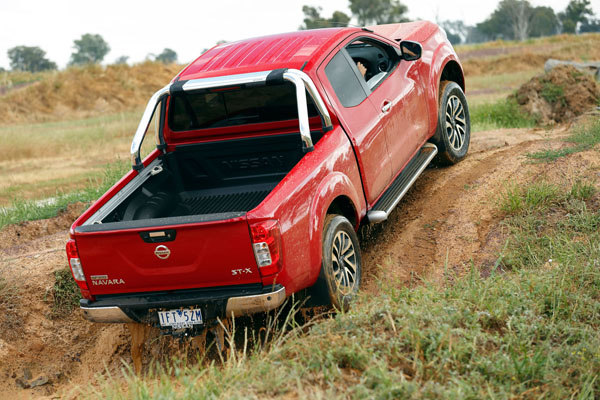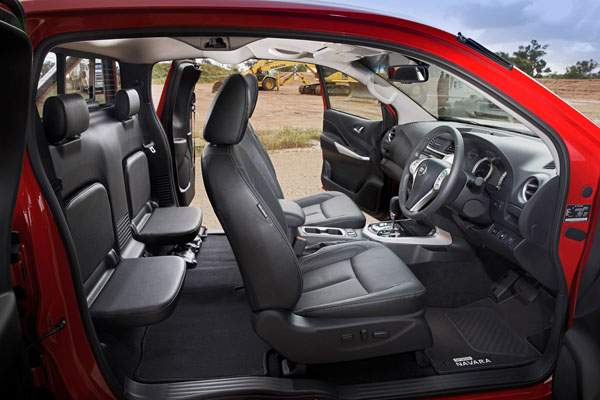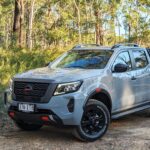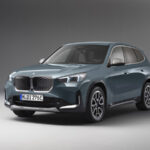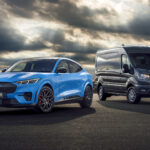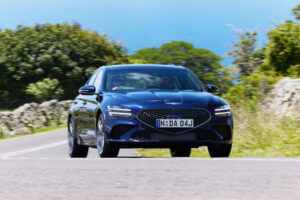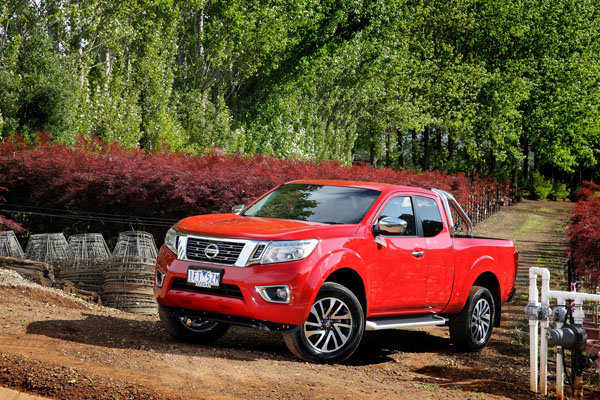
Midway through 2015 Nissan introduced what could be described as the passenger variants of its all-new NP300 Navara pickup range to Australia. Now the rest of the range is here. The workhorses have arrived, though it’s hard to describe them as workhorses because there’s plenty of style to their looks both inside and out.
Gone are the days when pickups were purely working vehicles, built down to a price, aimed only at tradies and farmers – and looking like it. All-new Navara shows Nissan is well aware that many pickups are now used as family transport and, even more importantly, are treated with pride by the tradies.
So the appearance of the just released Navara is big and bold with the signature Nissan ‘V-motion’ grille tying in nicely with the sweeping lines of the bonnet and guards. The V-Motion motif is repeated in the shaping of the central area of the tailgate and incorporates the Nissan badge. Nissan assures us the bold front isn’t just for show, built-in aerodynamic efficiency is a bonus.
The May launch of the Navara saw Australians receive seven variants, now there are no fewer than 32 to choose from.
The biggest news in the workhorse versions of the new Navara is the use of an old-style leaf-spring rear suspension in place of the complex multi-link rear end used in models being used in less strenuous working conditions. However, a lot of work has gone into the design and construction of the leaf-spring rear, as well as the chassis and body, so the old bugbears of lack of ride comfort from leaf rear ends has largely been ironed out. More about our driving impressions on this later.
Three engines are on offer; the range begins with a price leading 2.5-litre petrol engine. Similar to that used in the Nissan X-Trail and Altima it produces 122 kW and 238 Nm.
Diesels seem sure to dominate sales, with Nissan Australia forecasting them making up about 95 per cent of sales. There’s a humdinger 2.3-litre four-cylinder twin-turbo unit with 140 kW of power, and 450 Nm of torque from 1500 to 2500rpm. The engine is also available in single-turbo diesel unit, producing 120 kW of power and 403 Nm of torque.
Six-speed manual and seven-speed automatic transmissions are on offer.
Navara comes in 2WD (the rear wheels) or 4WD. The latter are sold in a big variety of models and are likely to be far the more popular.
Braked towing capacity on all diesel grades is as high as 3500 kg, an important feature in this segment.
Body types are Single Cab, King Cab and Dual Cab. The King Cab is interesting in that it has rear ‘suicide’ doors to provide reasonably easy entry. There is a pair of small fold-down seat in the back, when these aren’t in use the area can cope with quite large items securely and out of the weather.
Navara Dual Cab is a large vehicle these days, so has seating capable of housing five adults with plenty of room around them. You wouldn’t describe it as limo-like in the back, but it doesn’t miss by all that much.
Safety is rated at five stars thanks, in part to the use of seven airbags, which includes one for the driver’s knees.
We road tested all three engines on a long roundabout road drive out of Albury, which included a fair bit of poor dirt in several areas. The hum of the engines was sophisticated and well insulated, only a few years back some cars created more noise than these modern commercial Nissan units.
Some body roll was obvious on quicker bends, otherwise ride and handling were, again, almost car-like. Steering and brakes – ventilated discs at the front and drums in the rear – were equal to the task and never showed signs of fading, even when we had a decent load on board.
After the road drive we went to a special off-road and equipment-training compound operated by TAFE out of Albury to really put the 4WD Navaras through their paces. There was nothing particularly challenging about the work we did, suffice to say the NP300 Navara handled moguls, semi-difficult climb and descents and a 400 millimetre extended water crossing without even breathing hard.
Almost all pickups sold in Australia are made in Thailand these days. The Nissan factory there is producing quality work. Though we didn’t get to visit that facility during our trip to Thailand with Nissan earlier this year, the Navaras we examined over there and now on three different occasions in Australia are all neatly screwed together.
Nissan Australia is very buoyant about the future of the all-new NP300 Navara in Australia, which comes as no surprise when you learn that close to 300,000 Navaras have been sold in this country. Indeed, the celebrations for Navara number 300,000 look likely to come up only a few days before the Christmas and New Year celebrations take place.
Single Cab prices range from $19,490 for a DX petrol 4×2 cab chassis to $32,990 for an RX diesel 4×4 cab chassis; King Cabs from $28,490 for an RX diesel 4×2 cab chassis to $48,990 for an ST-X 4×4 diesel pickup; and Dual Cabs from $26,490 for a DX 4×2 petrol pickup to $51,990 for a ST-X 4×4 diesel pickup.
Note that these prices do not include government or dealer delivery charges. Contact your local Nissan dealer for driveaway prices.




